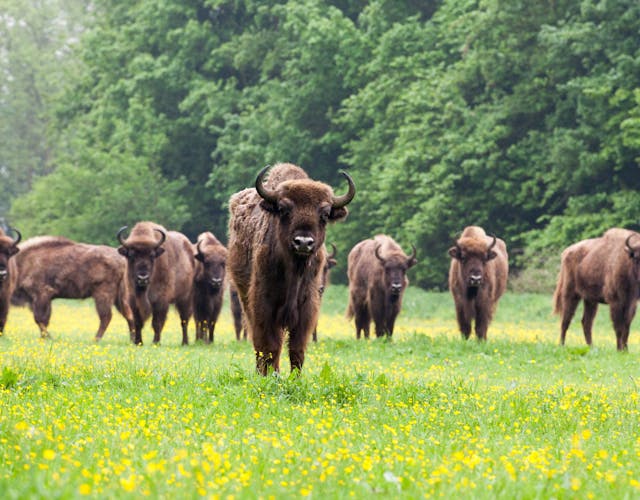Exmoor pony
The Exmoor pony is – like the Przewalski horse – a subspecies of the wild horse. These ponies have survived since prehistoric times in isolated areas in the United Kingdom, such as Exmoor National Park, after which they are named. Exmoor ponies are characterized by their light or dark brown coat with a mealy snout. In the Netherlands, they are increasingly used for grazing nature reserves.

Exmoor ponies have only been living in Natuurpark Lelystad for a relatively short time. At the beginning of 2024, three mares and a stallion were brought to the park to keep the last Przewalski horses in the park company. The herd of Przewalski horses in Natuurpark Lelystad was getting smaller and smaller due to old age. So small, in fact, that the remaining Przewalskis began to miss the group dynamics and social contacts with other horses. The older horses became lethargic, overweight and looked listless. By adding the Exmoor ponies to the herd, a dynamic, vital herd with natural behaviour was created again. The Przewalskis visibly came to life after the arrival of the Exmoors.
Name: Exmoor pony Species name: Equus ferus caballus Family: Equus ferus Habitat: United Kingdom Length: 1.15 - 1.30 metres high Weight: 300 - 350 kg Food: grass and herbs

Pangaré markings
The Exmoor is a fairly small pony. Mares are between 1.15 and 1.25 meters tall. Stallions and geldings are usually slightly larger (1.20 to 1.30 meters). The ponies are light brown to dark brown in color. They have light gray rings around the eyes. The belly and the inside of the thighs are much lighter colored than the back. All Exmoors display pangaré (“mealy”) markings around the eyes, muzzle and underbelly.

Wild traits
Exmoor ponies strongly resemble cave drawings of wild ponies from the Ice Age and the Przewalski horse. Just like the Przewalski horse, the Exmoor pony has different DNA than domesticated horse breeds. Both the Exmoor and the Przewalski therefore still show many strikingly ‘wild’ traits. For example, the animals are insensitive to all kinds of horse diseases and they can withstand the cold very well (they can survive perfectly well during severe winters, without shelter or extra food). This makes them ideal for living independently in nature reserves all year round and displaying natural, wild behaviour there.

Completely self-reliant
Exmoors are completely self-reliant and can survive very well in nature. By the way the ponies graze and digest their food, they spread plant seeds and by eating young trees and other low growth, they keep forest and heathland areas open. This stimulates the increase of certain rare plants, insects and birds.

Coexistence with European bison
The Exmoor ponies in Lelystad Nature Park share their habitat with a herd of European bison. In the past, the herd of Przewalski’s horses shared the area with the bison. The coexistence of horses and bovids is beneficial for both species and for the natural dynamics of the area. For example, bison and horses eat different foods. Horses primarily eat grass and herbs, while bison also eat leaves and tree bark. This creates open spaces in the area. Both species create sandy pits in the area, which in turn is beneficial for various insect species.
Because Exmoor ponies have lived in the rugged landscape of Exmoor National Park for centuries, they have adapted to eating tough, fibrous grasses. They have developed strong jaws and teeth, enabling them to graze through even the toughest vegetation.
Did you know? - Exmoor ponies are known to be friendly, reliable, lively and intelligent. - Unlike Przewalski's, Exmoor ponies can be tamed. The ponies are often used to learn how to ride. - The Exmoor pony has remained virtually unchanged since prehistoric times. Rock drawings, such as in the caves of Lascaux, show ponies that look very much like the Exmoor pony. - The Exmoors are having a great time in Lelystad Nature Park. Several foals have already been born.
